Abstract
1. The characteristics of hypoxic ventilation were studied in awake adult rats after brain transections about the intercollicular level. The results were compared with studies made before transection, 17-24 h after bilateral carotid body denervation effected by carotid sinus nerve section. 2. Transection at or below the intercollicular level converted the depressive hypoxic frequency response of control studies to a stimulatory response, increased the stimulation of tidal volume by hypoxia, and so converted the dominant pattern of ventilation in hypoxia from a depression to a progressive stimulation. 3. Transection above the intercollicular level failed to reverse the hypoxic frequency response but increased the stimulation of tidal volume by hypoxia. Consequently minute ventilation progressively increased as the severity of hypoxia increased. 4. The experiments demonstrate that in the adult rat depression of respiratory frequency by hypoxia after carotid body denervation requires the integrity of a region at or immediately above the intercollicular level. In contrast, the stimulation of tidal volume by hypoxia is markedly dependent upon precollicular structures. 5. The results are discussed in relation to the hypoxic depression of fetal breathing and the biphasic hypoxic ventilatory response of the newborn.
Full text
PDF
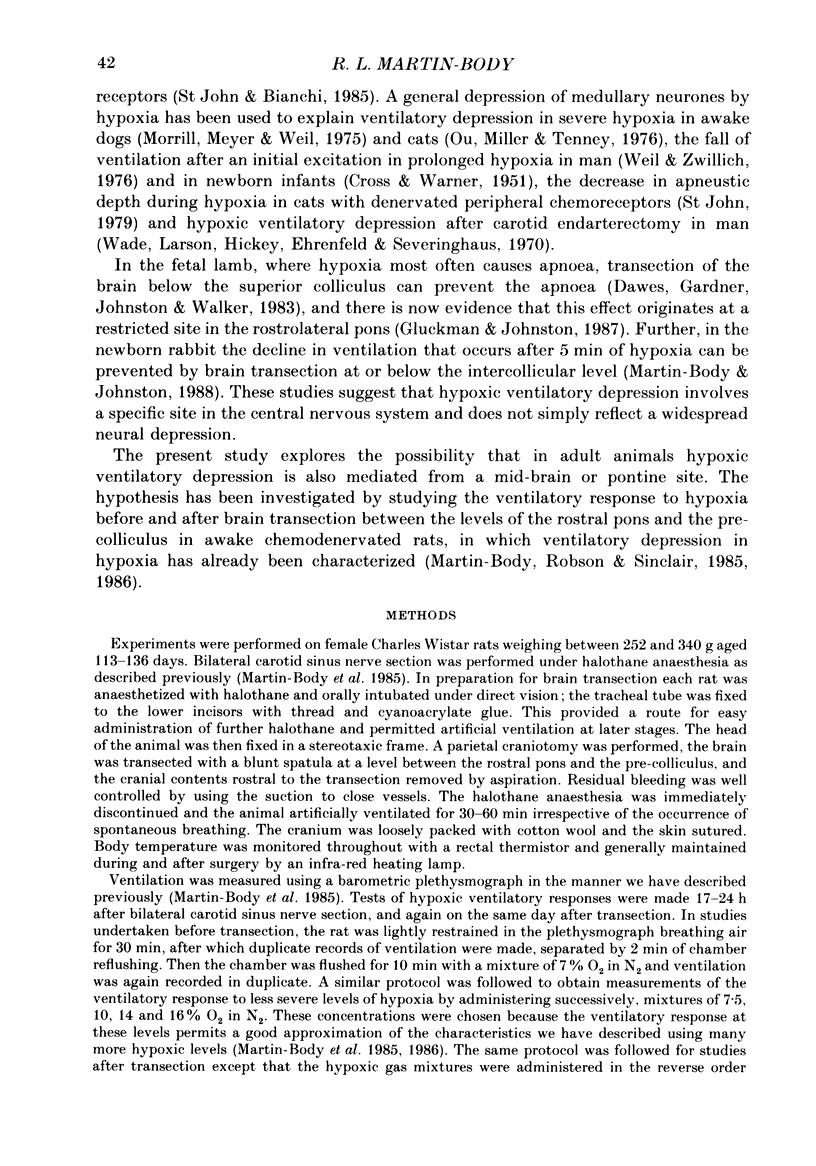
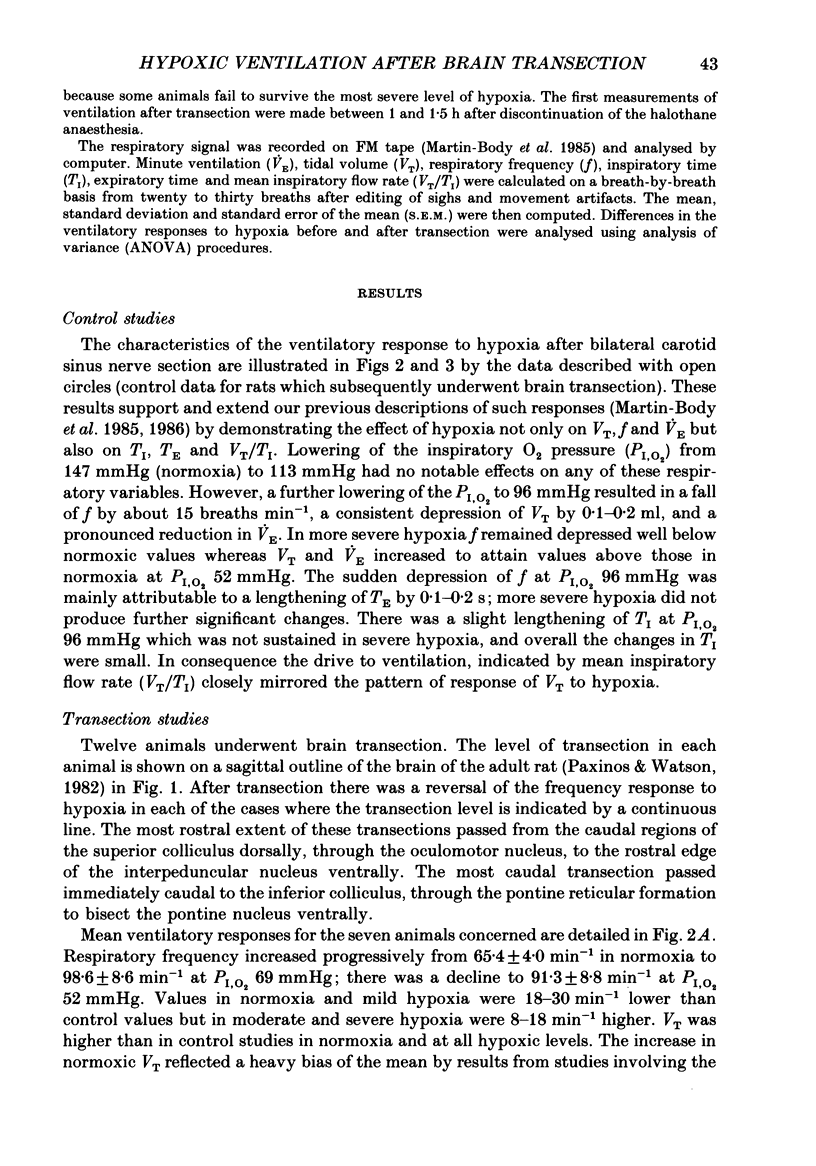
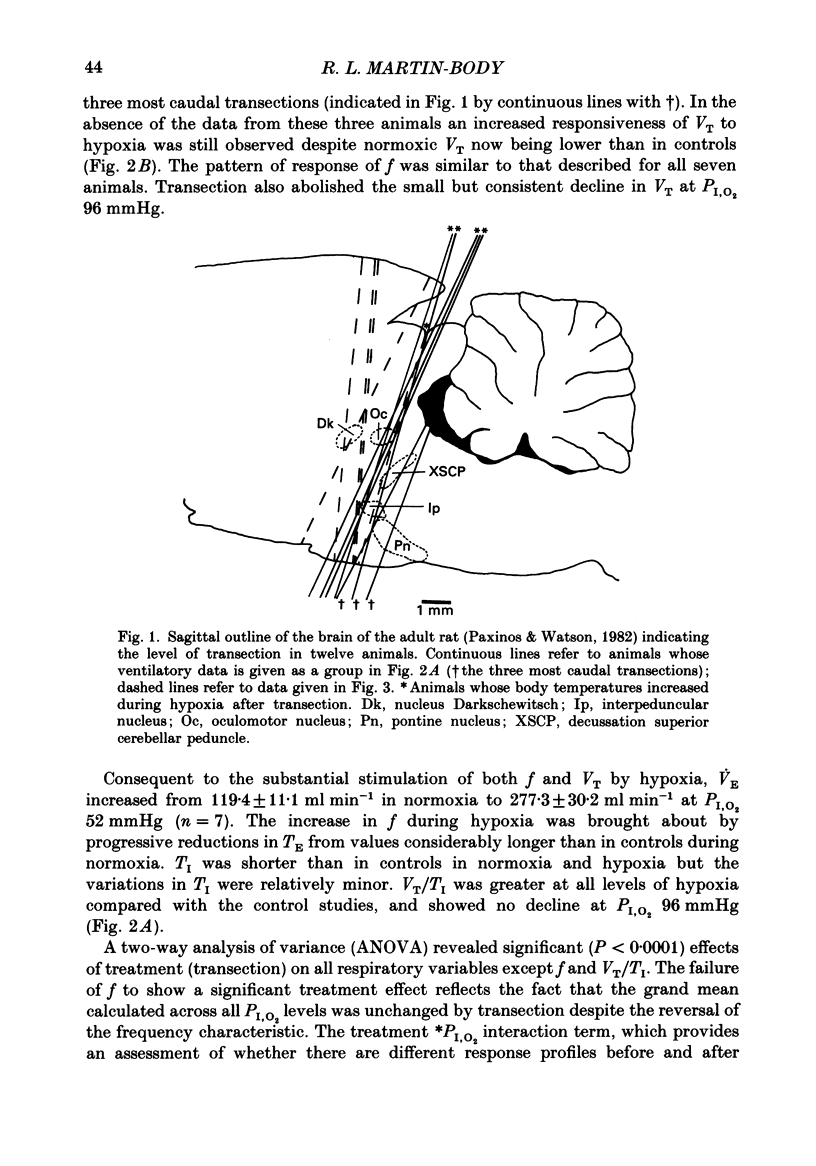

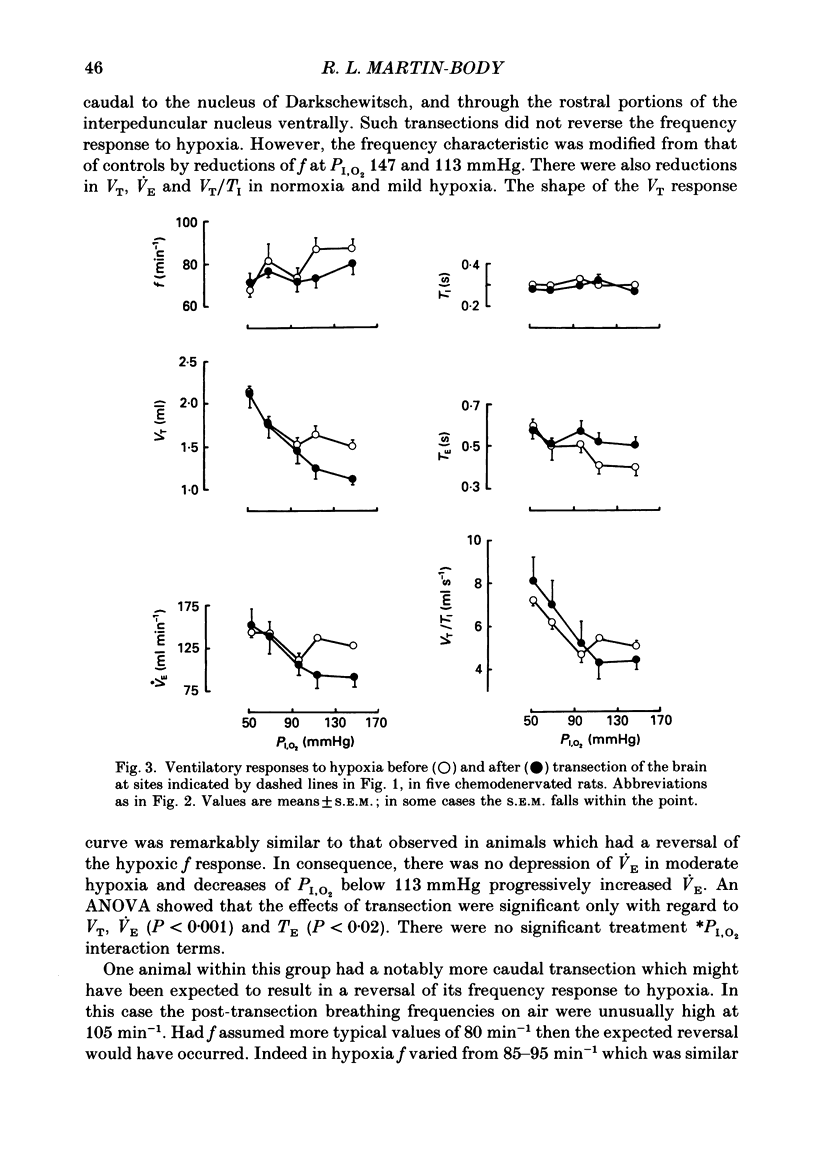
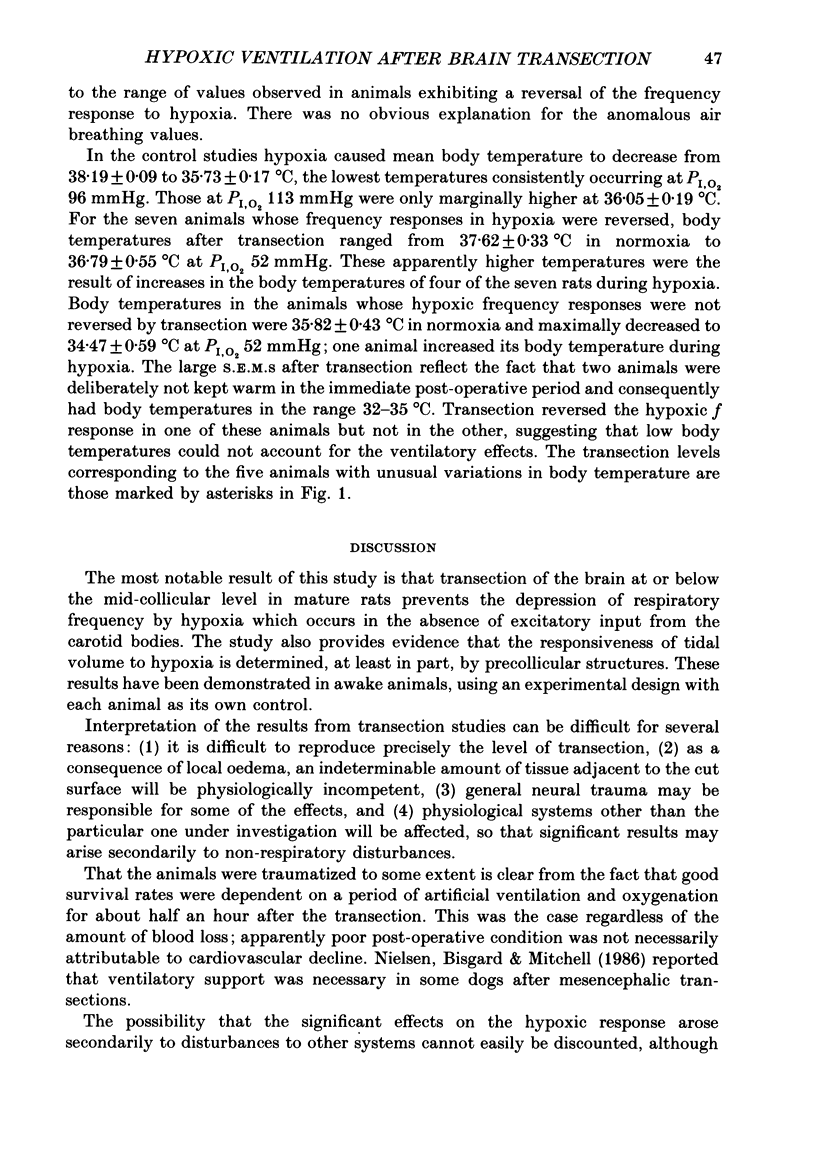
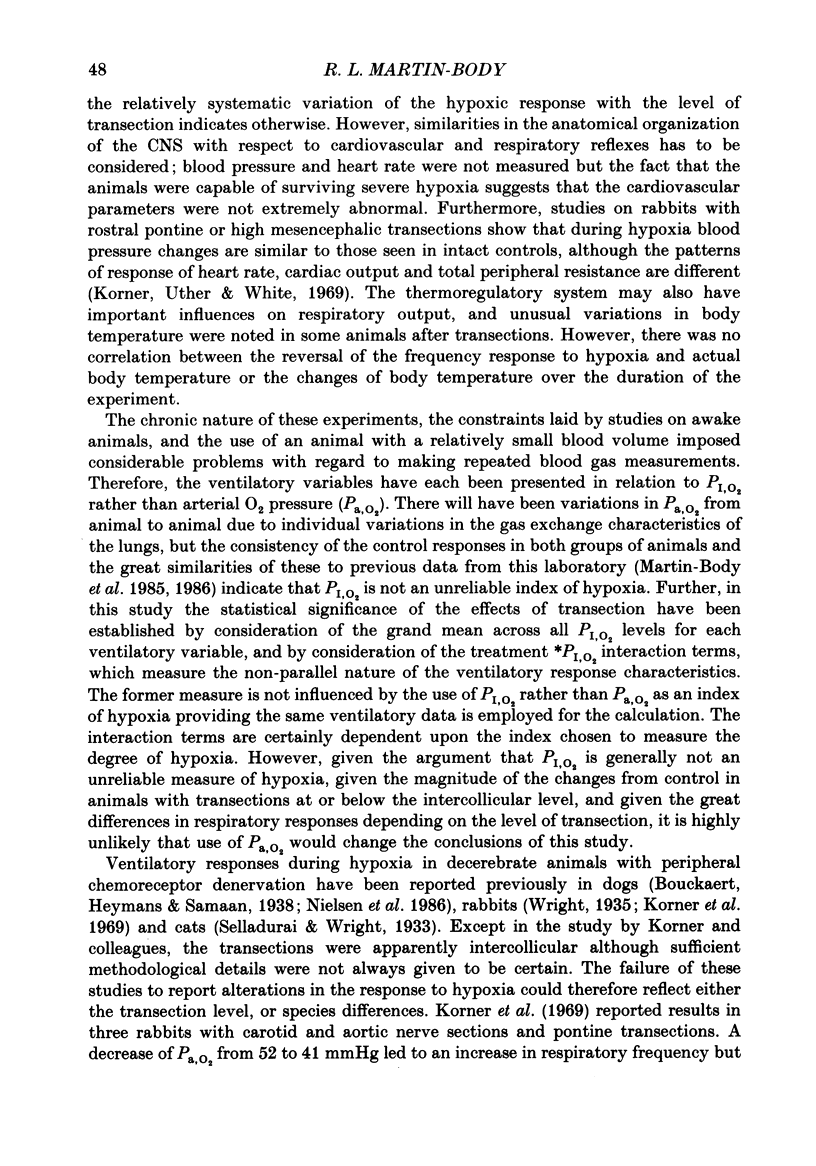
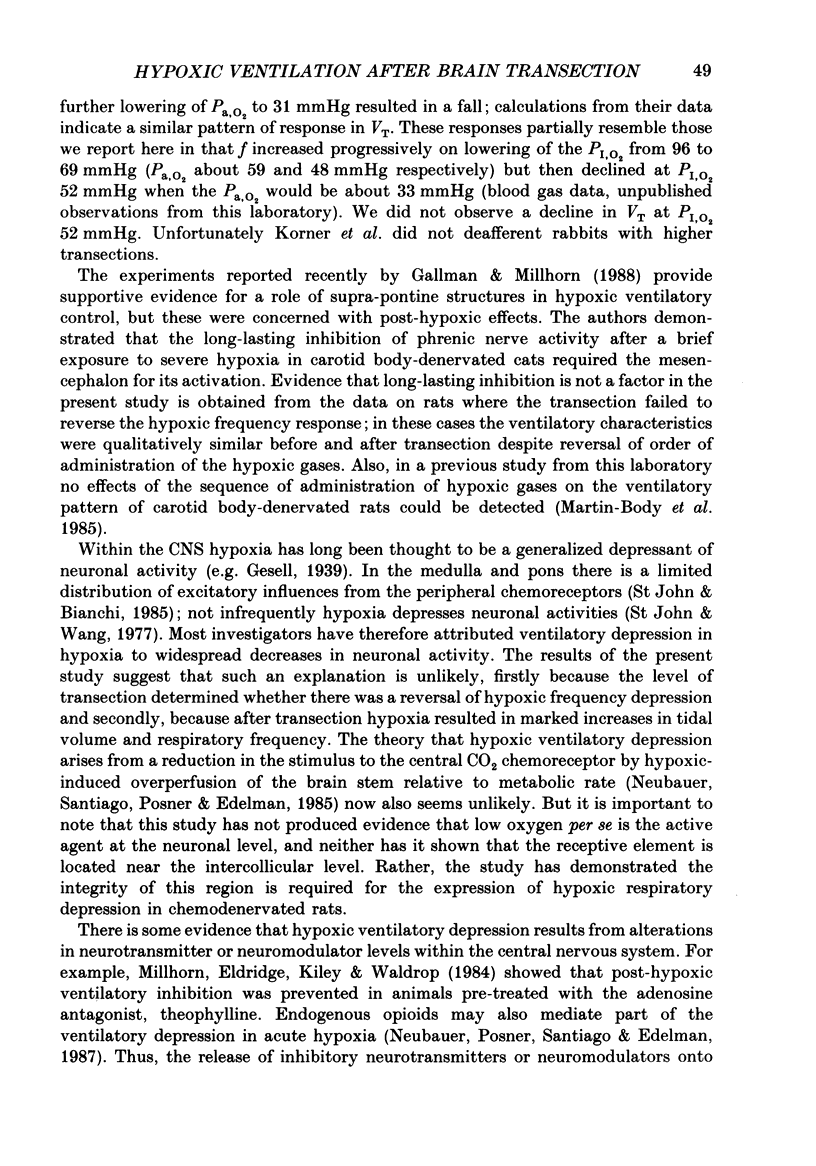

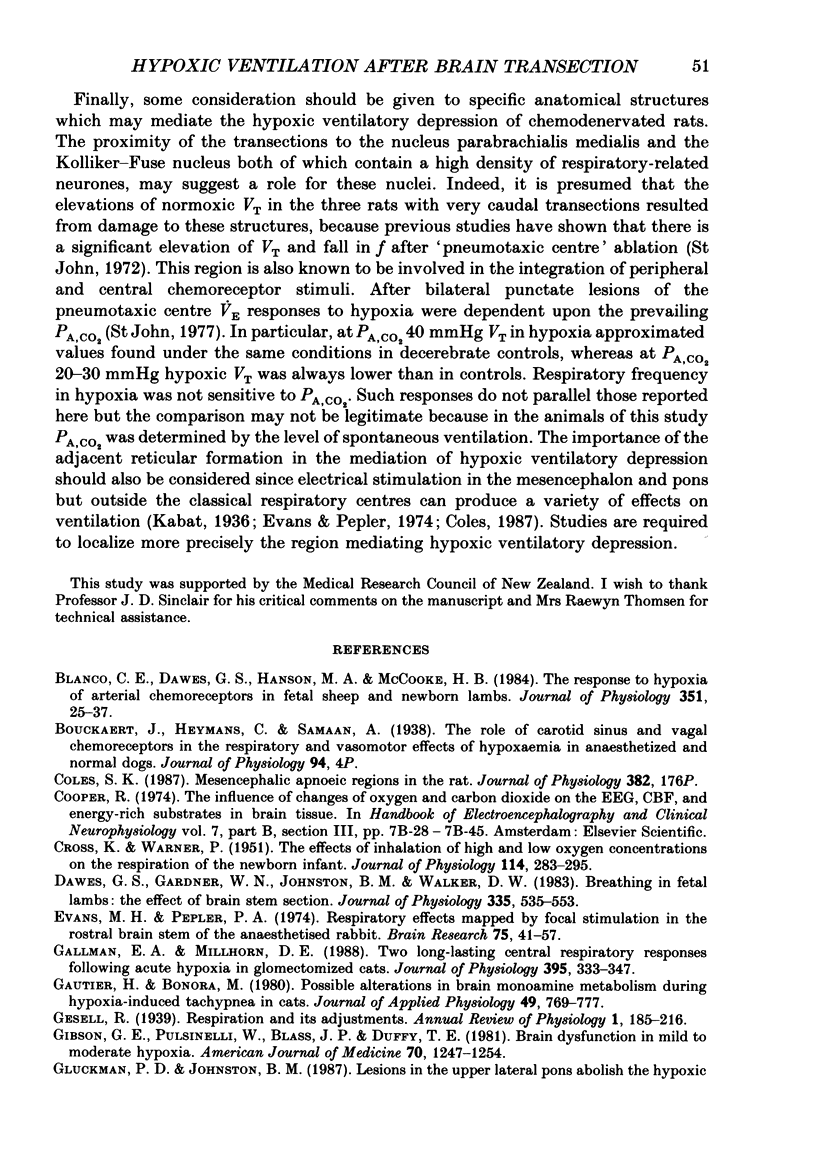

Selected References
These references are in PubMed. This may not be the complete list of references from this article.
- Blanco C. E., Dawes G. S., Hanson M. A., McCooke H. B. The response to hypoxia of arterial chemoreceptors in fetal sheep and new-born lambs. J Physiol. 1984 Jun;351:25–37. doi: 10.1113/jphysiol.1984.sp015229. [DOI] [PMC free article] [PubMed] [Google Scholar]
- CROSS K. W., WARNER P. The effect of inhalation of high and low oxygen concentrations on the respiration of the newborn infant. J Physiol. 1951 Jul;114(3):283–295. doi: 10.1113/jphysiol.1951.sp004620. [DOI] [PMC free article] [PubMed] [Google Scholar]
- Dawes G. S., Gardner W. N., Johnston B. M., Walker D. W. Breathing in fetal lambs: the effect of brain stem section. J Physiol. 1983 Feb;335:535–553. doi: 10.1113/jphysiol.1983.sp014549. [DOI] [PMC free article] [PubMed] [Google Scholar]
- Evans M. H., Pepler P. A. Respiratory effects mapped by focal stimulation in the rostral brain stem of the anaesthetised rabbit. Brain Res. 1974 Jul 19;75(1):41–57. doi: 10.1016/0006-8993(74)90769-0. [DOI] [PubMed] [Google Scholar]
- Gallman E. A., Millhorn D. E. Two long-lasting central respiratory responses following acute hypoxia in glomectomized cats. J Physiol. 1988 Jan;395:333–347. doi: 10.1113/jphysiol.1988.sp016922. [DOI] [PMC free article] [PubMed] [Google Scholar]
- Gautier H., Bonora M. Possible alterations in brain monoamine metabolism during hypoxia-induced tachypnea in cats. J Appl Physiol Respir Environ Exerc Physiol. 1980 Nov;49(5):769–777. doi: 10.1152/jappl.1980.49.5.769. [DOI] [PubMed] [Google Scholar]
- Gibson G. E., Pulsinelli W., Blass J. P., Duffy T. E. Brain dysfunction in mild to moderate hypoxia. Am J Med. 1981 Jun;70(6):1247–1254. doi: 10.1016/0002-9343(81)90834-2. [DOI] [PubMed] [Google Scholar]
- Gluckman P. D., Johnston B. M. Lesions in the upper lateral pons abolish the hypoxic depression of breathing in unanaesthetized fetal lambs in utero. J Physiol. 1987 Jan;382:373–383. doi: 10.1113/jphysiol.1987.sp016372. [DOI] [PMC free article] [PubMed] [Google Scholar]
- John W. M., Wang S. C. Response of medullary respiratory neurons to hypercapnia and isocapnic hypoxia. J Appl Physiol Respir Environ Exerc Physiol. 1977 Nov;43(5):812–821. doi: 10.1152/jappl.1977.43.5.812. [DOI] [PubMed] [Google Scholar]
- Korner P. I., Uther J. B., White S. W. Central nervous integration of the circulatory and respiratory responses to arterial hypoxemia in the rabbit. Circ Res. 1969 Jun;24(6):757–776. doi: 10.1161/01.res.24.6.757. [DOI] [PubMed] [Google Scholar]
- Martin-Body R. L., Johnston B. M. Central origin of the hypoxic depression of breathing in the newborn. Respir Physiol. 1988 Jan;71(1):25–32. doi: 10.1016/0034-5687(88)90112-0. [DOI] [PubMed] [Google Scholar]
- Martin-Body R. L., Robson G. J., Sinclair J. D. Respiratory effects of sectioning the carotid sinus glossopharyngeal and abdominal vagal nerves in the awake rat. J Physiol. 1985 Apr;361:35–45. doi: 10.1113/jphysiol.1985.sp015631. [DOI] [PMC free article] [PubMed] [Google Scholar]
- Martin-Body R. L., Robson G. J., Sinclair J. D. Restoration of hypoxic respiratory responses in the awake rat after carotid body denervation by sinus nerve section. J Physiol. 1986 Nov;380:61–73. doi: 10.1113/jphysiol.1986.sp016272. [DOI] [PMC free article] [PubMed] [Google Scholar]
- Miller M. J., Tenney S. M. Hypoxia-induced tachypnea in carotid-deafferented cats. Respir Physiol. 1975 Jan;23(1):31–39. doi: 10.1016/0034-5687(75)90069-9. [DOI] [PubMed] [Google Scholar]
- Millhorn D. E., Eldridge F. L., Kiley J. P., Waldrop T. G. Prolonged inhibition of respiration following acute hypoxia in glomectomized cats. Respir Physiol. 1984 Sep;57(3):331–340. doi: 10.1016/0034-5687(84)90081-1. [DOI] [PubMed] [Google Scholar]
- Morrill C. G., Meyer J. R., Weil J. V. Hypoxic ventilatory depression in dogs. J Appl Physiol. 1975 Jan;38(1):143–146. doi: 10.1152/jappl.1975.38.1.143. [DOI] [PubMed] [Google Scholar]
- Neubauer J. A., Posner M. A., Santiago T. V., Edelman N. H. Naloxone reduces ventilatory depression of brain hypoxia. J Appl Physiol (1985) 1987 Aug;63(2):699–706. doi: 10.1152/jappl.1987.63.2.699. [DOI] [PubMed] [Google Scholar]
- Neubauer J. A., Santiago T. V., Posner M. A., Edelman N. H. Ventral medullary pH and ventilatory responses to hyperperfusion and hypoxia. J Appl Physiol (1985) 1985 May;58(5):1659–1668. doi: 10.1152/jappl.1985.58.5.1659. [DOI] [PubMed] [Google Scholar]
- Nielsen A. M., Bisgard G. E., Mitchell G. S. Phrenic nerve responses to hypoxia and CO2 in decerebrate dogs. Respir Physiol. 1986 Sep;65(3):267–283. doi: 10.1016/0034-5687(86)90012-5. [DOI] [PubMed] [Google Scholar]
- Ou L. C., Tenney S. M. Hypoxia and carbon dioxide as separate and interactive depressants of ventilation. Respir Physiol. 1976 Dec;28(3):347–358. doi: 10.1016/0034-5687(76)90029-3. [DOI] [PubMed] [Google Scholar]
- Rothwell N. J., Stock M. J., Thexton A. J. Decerebration activates thermogenesis in the rat. J Physiol. 1983 Sep;342:15–22. doi: 10.1113/jphysiol.1983.sp014836. [DOI] [PMC free article] [PubMed] [Google Scholar]
- St John W. M., Bianchi A. L. Responses of bulbospinal and laryngeal respiratory neurons to hypercapnia and hypoxia. J Appl Physiol (1985) 1985 Oct;59(4):1201–1207. doi: 10.1152/jappl.1985.59.4.1201. [DOI] [PubMed] [Google Scholar]
- St John W. M. Differential alteration by hypercapnia and hypoxia of the apneustic respiratory pattern in decerebrate cats. J Physiol. 1979 Feb;287:467–491. doi: 10.1113/jphysiol.1979.sp012671. [DOI] [PMC free article] [PubMed] [Google Scholar]
- St John W. M. Integration of peripheral and central chemoreceptor stimuli by pontine and medullary respiratory centers. Fed Proc. 1977 Sep;36(10):2421–2427. [PubMed] [Google Scholar]
- St John W. M. Respiratory tidal volume responses of cats with chronic pneumotaxic center lesions. Respir Physiol. 1972 Sep;16(1):92–108. doi: 10.1016/0034-5687(72)90091-6. [DOI] [PubMed] [Google Scholar]
- Wade J. G., Larson C. P., Jr, Hickey R. F., Ehrenfeld W. K., Severinghaus J. W. Effect of carotid endarterectomy on carotid chemoreceptor and baroreceptor function in man. N Engl J Med. 1970 Apr 9;282(15):823–829. doi: 10.1056/NEJM197004092821501. [DOI] [PubMed] [Google Scholar]
- Weil J. V., Zwillich C. W. Assessment of ventilatory response to hypoxia: methods and interpretation. Chest. 1976 Jul;70(1 Suppl):124–128. [PubMed] [Google Scholar]


